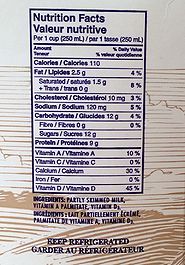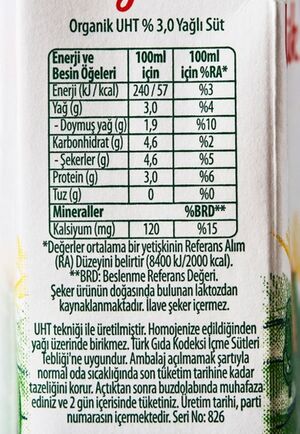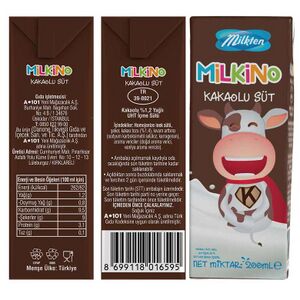Course:FNH200/Projects/2023/Milk: Fat Content Regulations and Labelling Requirements Across Canada and Turkey
Introduction
There are a lot of safety rules and regulations when it comes to manufacturing and selling milk, which differ in various countries. We are going to explore the fat content regulations and labeling requirements for milk in Canada and Turkey.
Canada Fat Content Regulations
In Canada, the milk fat content in dairy products is regulated by the Canadian Food Inspection Agency (CFIA) under the Food and Drug Regulations. These regulations set standards for various dairy products, including milk, cream, butter, cheese, and other milk-based products.The milk fat content is usually expressed as a percentage.
Prevalent standards include whole milk with a minimum of 3.25% milk fat, when a portion of the milk’s fat is removed, it is called partly skimmed milk (2% milk) at around 2% milk fat, and skim milk (0% milk) containing less than 0.5% milk fat.
Cream is categorised into various types based on milk fat content. These include light cream (5-6% milk fat), coffee cream (10% milk fat), whipping cream (32-36% milk fat), and heavy cream (36% or more milk fat). Different types of cream are used for specific culinary and baking purposes. Butter must contain at least 80% milk fat.
Cheese fat content varies widely by type, with soft cheeses having less and harder cheeses containing more milk fat. Yogurt's milk fat content also varies, with full-fat Yogurt having more fat than low-fat or fat-free options.
Processed dairy products like ice cream, frozen desserts, and dairy-based spreads also have regulated milk fat content. Ice cream, for example, must have a minimum of 10% milk fat.
Canada Labelling Requirements
The labelling requirements for dairy products in Canada are outlined in detail to ensure accurate and informative labeling for both domestic and imported products. Dairy products encompass foods derived from mammal milk and are regulated under various laws and regulations including the Safe Food for Canadians Act (SFCA), Safe Food for Canadians Regulations (SFCR), Food and Drugs Act (FDA), and Food and Drug Regulations (FDR). These regulations apply to products traded interprovincially, imported, exported, and even intraprovincially in some cases.
The labelling requirements for dairy products encompass various aspects, including exemptions for certain consumer prepackaged dairy products sold through vending machines, restaurants, or commercial enterprises, and the specification of common names for standardized and non-standardized dairy products. The term "milk" must be used specifically for cow's milk unless otherwise designated, with clear indication if other animal sources are used. Modified standardized common names are required for dairy products that deviate from prescribed standards. Additional terms such as "whipped," "cultured," "unsalted," and "salted" must be included based on characteristics like firmness, ripening, and ingredients.
For dairy products with a shelf life of 90 days or less, date markings and storage instructions must adhere to general requirements. Nutrition labelling applies to dairy products, with certain exemptions, and serving sizes are based on the edible portion aligned with reference amounts. Grade names, when used, should conform to Canadian standards and appear on the packaging.
The use of "100% Canadian milk" claims must be truthful and not misleading, while comparative claims involving cream cheese must align with specific regulations. A labelling recommendation exists for cheese made from raw or unpasteurized milk. Definitions include terms like "consumer prepackaged," "dairy product," "foreign state," "milk," "milk product," "milk solids," and "person," clarifying regulatory terms used throughout the labelling requirements.
Turkey Fat Content Regulations
In Turkey, milk and dairy products are subject to regulations set by the Ministry of Agriculture and Forestry, as well as the Turkish Food Codex (Türk Gıda Kodeksi), which is a comprehensive set of regulations that govern various aspects of food safety, labeling, and quality standards in the country.
Milk fat content regulations typically stipulate the minimum and maximum permissible levels of fat in different types of dairy products, including milk. These regulations are in place to ensure that consumers receive products that meet certain quality and nutritional standards.
The Turkish milk fat content regulation allows for the adjustment of fat content in drinking milk through the addition of cream, whether separated or whole, as well as other milk types like semi-skimmed, low-fat, or skimmed milk. The specified ratios for "% Protein" and "% Fat-free dry matter" outlined in Annex-1 must be adhered to for milk brought to the market under this regulation. It's emphasized that the milk falling under this regulation should solely contain milk fat and no other animal fat or vegetable oil. However, in the case of seasoned milks, vegetable oil might be present, but its amount is limited to the proportion of seasoning used.
The milk fat content standards for various types of drinking milk are as follows:
For full-fat milk, the milk fat content should be 3.5 grams or less per 100 milliliters of milk. In the case of semi-skimmed milk, the milk fat content should range from 1.5 grams to less than 1.8 grams per 100 milliliters. For fat-free milk, the milk fat content should be less than 0.15 grams per 100 milliliters. These specifications dictate the permissible fat levels in different categories of milk.
Turkey Labelling Requirements
Firstly the official name of the product should be named in the label. And then, if there is a flavour included in the milk, then the name of the flavour should be included along with its official name. For example “chocolate milk” would be an accurate name for the label.
The label should include the list of ingredients, nutrition facts, production date, expiration date, and allergy causing substances and products. The net quantity of the food, any special storage conditions should be on the label.
Food business operator’s business name and address, facility registration number and country of origin should be on the label.
If the milk was extracted from any animal that isn't a cow, the label should tell which animal it is from.
It should include how much sugar is in the milk in percentage. Additionally, if some lactose was removed from the milk, the label should tell the amount of lactose removed in percentage.
If a product's shelf life was extended by packaging gases, then label should include the statement "packaged in a protective atmosphere"
If the milk contains sweeteners, or aspartame, the label should tell that it contains them.
Added vitamins and minerals should be included in the label.
The pasteurized milks are required to show negative reaction to the alkaline phosphatase test and positive reaction to the peroxidase test. And in the event that the peroxidase reaction test outcome differs from the expected outcome, a statement that says that the milk was pasteurized at high temperature should be put on the label
The information should be clear, accurate and easy to understand for an average person.
The label is required to give all the information in Turkish. Using other languages is optional.
Sources
https://www.ab.gov.tr/files/tarama/tarama_files/11/sorular_cevaplar_files/cevaplar/Sut_ilave_EK1.pdf
https://members.wto.org/crnattachments/2018/SPS/TUR/18_2510_00_e.pdf
https://healthunit.org/wp-content/uploads/CFIA_ACIA-Labelling-Presentation-for-Industry.pdf
https://inspection.canada.ca/food-labels/labelling/industry/dairy/eng/1624983427586/1624983674393
Exam Question
Choose all the correct options about the differences between Turkish and Canadian Milk. [Answers: A, D, E]
- A. Full-fat in Canada must have a minimum of 3.25% milk fat
- B. Full-fat in Turkey must have a minimum of 3.25% milk fat
- C. Plain Turkish milk that falls under the Annex-1 regulations is allowed to have animal fat in it.
- D. The Canadian Food Inspection Agency (CFIA) regulates the milk fat content in dairy products.
- E. In both Canada and Turkey the term ‘Milk’ on a carton is only used for cow’s milk and all other milk has to specify the animal it came from.
- Explanation:
- A is correct because taking a look at the second paragraph in the Canada Milk Fat section on the wiki. It is clearly stated that the standards for whole milk, which is another word for full-fat milk, is that the milk must have a fat content of minimum 3.25%.
- The answer to D is found in the first sentence of the Canada Milk Fat section on the wiki, where its stated that the CFIA regulates the milk fat content of dairy products in Canada.
- E is correct as both countries have regulations for labeling milk products correctly, specifically in the 4th paragraph of the Turkey Labeling Requirements section it states, “If the milk was extracted from any animal that isn't a cow, the label should tell which animal it is from.” and in the second paragraph of the Canada Labeling section it states “The term "milk" must be used specifically for cow's milk unless otherwise designated, with clear indication if other animal sources are used.”
- B is incorrect as Turkish rules state that full-fat milk must have less than 3.5% milk fat content as shown in the Turkey Milk Fat section on the wiki.
- C is incorrect as in the Turkey Milk Fat section on the wiki the rules given state that “the milk falling under this regulation should solely contain milk fat and no other animal fat or vegetable oil.”
This is a good exam question because milk is a common food in most households both for drinking and as an ingredient, so many people wonder why milk tastes different in various regions around the world. This question highlights the differences and similarities between countries' regulations and answers the question on why dairy products may taste different in other countries.



